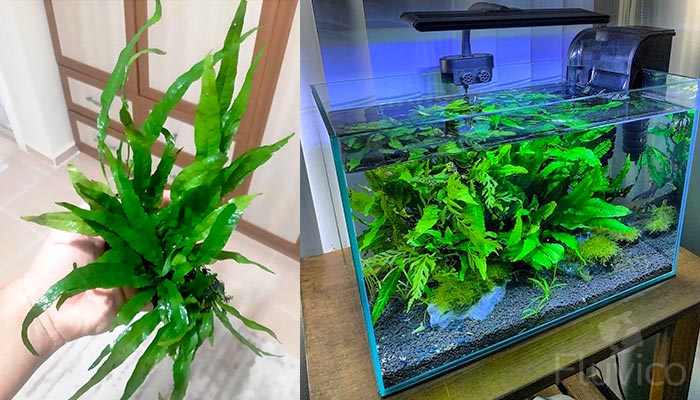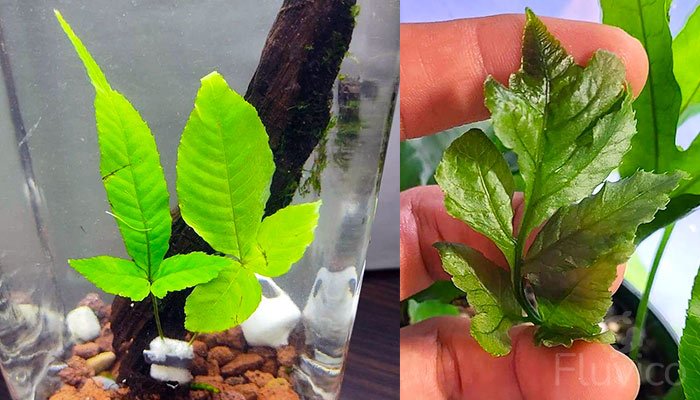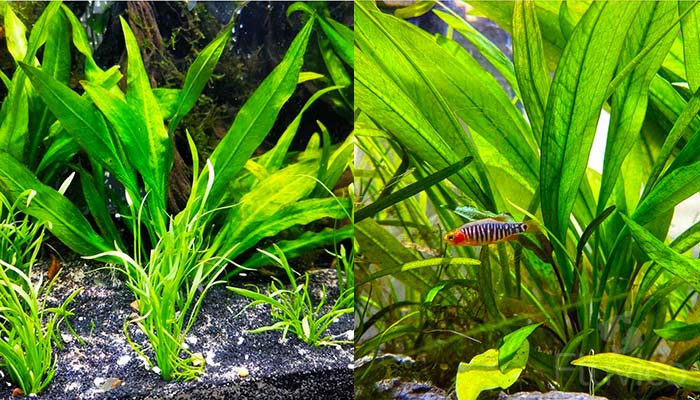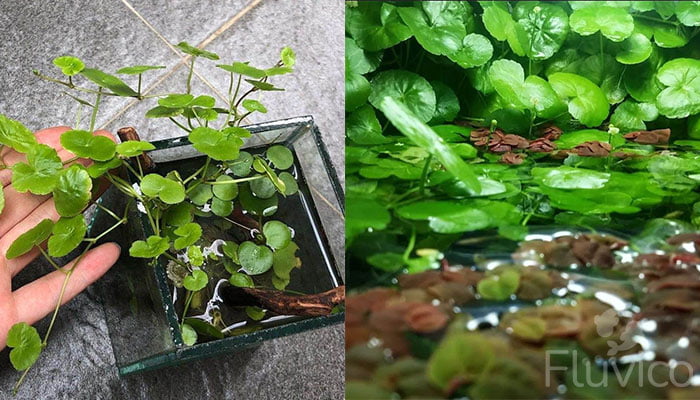Low light aquarium? Shaded spot? Beginner Tank? We got you covered!
Whether you just want the ease and convenience of maintenance-free low light aquarium plants, or have a specialised low-light pro setup. These are the best aquarium Mosses, Ferns and Stem Plants that are available widely worldwide.
As a beginner, having a low-light friendly plant means you don’t have to worry about optimal high-end lighting. The plants below will thrive regardless. The downside, is that they’ll often grow slowly, taking time to fill out.
The upside… less tank maintenance.
Table of Contents
Low-light Mosses
Not all aquarium mosses grow well in low light conditions, but many do. Mosses are generally adaptable and hardy plants that can tolerate a range of light intensities.
In nature, mosses often grow in shaded or partially shaded areas, such as on tree trunks or rocks, where light levels can be low. This ability to grow in low light environments has evolved as a survival strategy for these plants.
In an aquarium, mosses like Java Moss and Marimo Moss Balls are popular choices for low light setups. They can grow and thrive with minimal lighting, although their growth rate may be slower compared to higher light conditions.
Providing consistent and stable lighting, even at low intensities, will ensure that your mosses remain healthy and continue to grow.

Java Moss (Taxiphyllum barbieri)
Java Moss is a hardy, beginner-friendly moss that’s perfect for low light aquariums. It can easily attach to rocks, driftwood, or other surfaces, creating a beautiful green carpet. Java Moss requires minimal maintenance and provides a great hiding place for small fish and shrimp.
- Lighting: Moderate to high light needed
- Max Size: 4 inches (10 cm) long
- Thrive Conditions: Adapts to a variety of water conditions, prefers cooler temperatures and gentle water flow
- Beginner Friendly: Yes

Marimo Moss Balls (Aegagropila linnaei)
These unique, round-shaped moss balls are not only eye-catching but also extremely easy to care for. They’re perfect for beginners and low light setups, requiring minimal maintenance. Marimo Moss Balls help improve water quality by absorbing excess nutrients and provide a fun play area for fish.
- Lighting: Low to moderate light needed
- Max Size: Up to 8 inches (20 cm) diameter
- Thrive Conditions: Cooler temperatures, can tolerate a range of water conditions
- Beginner Friendly: Yes
Full Marimo Moss Care Guide (Grow, Propagate, FAQs, & Tips)
Low-Light Ferns
Not all aquarium ferns grow well in low light conditions, but many do. Those that thrive in low light environments, such as Java Fern and African Water Fern, adapted to survive in their natural habitats, where light is limited due to dense foliage, murky water, or deep water.
Evolving to photosynthesise at low light levels makes the Ferns listed below perfect for low-light aquariums or planting in shaded spots.

Java Fern (Microsorum pteropus)
Java Fern is an attractive, hardy plant that thrives in low light conditions. It’s beginner-friendly and can be attached to driftwood, rocks, or other decorations. Java Fern is slow-growing and doesn’t require much maintenance, making it a great choice for new aquarium hobbyists.
- Lighting: Low to moderate light needed
- Max Size: Up to 13.5 inches (35 cm) long
- Thrive Conditions: Adapts to a wide range of water conditions, prefers being attached to hardscape
- Beginner Friendly: Yes
Full Java Fern Care Guide (Grow, Propagate, FAQs, & Tips)

African Water Fern (Bolbitis heudelotii)
This beautiful fern can add a touch of elegance to your low light aquarium. It’s beginner-friendly and can be attached to driftwood or rocks. African Water Fern prefers stable water parameters and benefits from CO2 supplementation, but it’s not necessary for its growth.
- Lighting: Low to moderate light needed
- Max Size: Up to 16 inches (40 cm) long
- Thrive Conditions: Prefers warmer temperatures and good water flow, likes being attached to hardscape
- Beginner Friendly: Yes

Bolbitis heteroclita (Creeping Fern)
Bolbitis heteroclita, also known as Creeping Fern, is an attractive and intriguing plant that’s adapt to low light conditions. This plant is beginner-friendly due to its hardiness and ability to tolerate a wide range of water conditions. Creeping Fern is an epiphytic plant, meaning it prefers to attach itself to hardscape elements like driftwood, rocks, or other decorations in your aquarium.
- Lighting: Low to moderate light needed
- Max Size: Up to 10 inches (25 cm) long
- Thrive Conditions: Prefers good water flow, enjoys being attached to hardscape
- Beginner Friendly: Yes

Water Sprite (Ceratopteris thalictroides)
Although not a true fern, Water Sprite has a fern-like appearance and is an excellent low light plant. It can be grown floating or rooted in the substrate, providing cover for fish and invertebrates. Water Sprite is easy to care for and suitable for beginners.
- Lighting: Moderate to high light needed
- Max Size: Up to 20 inches (50 cm) long
- Thrive Conditions: Grows both submerged and floating, prefers slightly acidic to neutral pH
- Beginner Friendly: Yes
Stem Plants

Anubias (Anubias spp.)
Anubias plants are hardy, slow-growing, and perfect for low light aquariums. They’re beginner-friendly and can be attached to rocks, driftwood, or decorations. Anubias is available in various species, offering different leaf shapes and sizes to suit your aquarium’s aesthetic.
- Lighting: Low to moderate light needed
- Max Size: Varies by species, typically up to 16 inches (40 cm) long
- Thrive Conditions: Adapts to a wide range of water conditions, prefers being attached to hardscape
- Beginner Friendly: Yes
Full Anubuas Care Guide (Grow, Propagate, FAQs, & Tips)

Cryptocoryne (Cryptocoryne spp.)
Cryptocoryne, or “Crypts,” are adaptable plants that can thrive in low light conditions. They’re beginner-friendly and available in various species with different colours and leaf shapes.
Related: 15 Common & Rare Types of Cryptocoryne
Related: Cryptocoryne ‘Crypts’ Full Care & Growth Guide
Be patient, as Crypts may experience “melting” when first introduced to the tank, but they’ll bounce back with proper care.
- Lighting: Low to moderate light needed
- Max Size: Varies by species, typically up to 12 inches (30 cm) long
- Thrive Conditions: Tolerates a wide range of water parameters, prefers nutrient-rich substrate
- Beginner Friendly: Yes

Amazon Sword (Echinodorus spp.)
Amazon Swords are striking plants with large, sword-like leaves that make a great centerpiece in low light aquariums. They’re beginner-friendly and can be planted in the substrate. Amazon Swords may benefit from root tabs for added nutrients, but overall, they’re easy to care for.
- Lighting: Moderate to high light needed
- Max Size: Up to 20 inches (50 cm) long
- Thrive Conditions: Prefers slightly acidic to neutral pH, benefits from nutrient-rich substrate
- Beginner Friendly: Yes

Vallisneria (Vallisneria spp.)
Vallisneria (Vallisneria spp.): Vallisneria, or “Vals,” are long, grass-like plants that can create a beautiful underwater landscape in low light conditions. They’re easy to care for and suitable for beginners. Vals can reproduce by sending out runners, filling in empty spaces in your aquarium.
- Lighting: Moderate to high light needed
- Max Size: Up to 6 feet (183 cm) long, depending on the species
- Thrive Conditions: Adapts to a variety of water conditions, prefers sandy substrate
- Beginner Friendly: Yes (Yellows/Browns easily)

Water Wisteria (Hygrophila difformis)
Water Wisteria is a versatile, fast-growing plant that can thrive in low light settings. It’s beginner-friendly and can be grown floating or rooted in the substrate. Water Wisteria provides excellent shelter for fish and invertebrates and helps maintain water quality.
- Lighting: Moderate to high light needed
- Max Size: Up to 20 inches (50 cm) long
- Thrive Conditions: Adapts to a range of water parameters, prefers nutrient-rich substrate
- Beginner Friendly: Yes
Full Water Wisteria Care Guide (Grow, Propagate, FAQs, & Tips)

Hornwort (Ceratophyllum demersum)
Hornwort is a hardy, fast-growing plant that can adapt well to low light conditions. It’s beginner-friendly and can be grown floating or anchored in the substrate. Hornwort is an excellent oxygenator and provides shelter for fish and invertebrates, making it a valuable addition to your aquarium.
- Lighting: Moderate to high light needed
- Max Size: Up to 10 feet (3 m) long
- Thrive Conditions: Tolerates a wide range of water conditions, prefers to float freely
- Beginner Friendly: Yes
Full Hornwort Care Guide (Grow, Propagate, FAQs, & Tips)

Dwarf Sagittaria (Sagittaria subulata)
Dwarf Sagittaria is a grass-like plant that can grow well in low light conditions. It’s easy to care for and suitable for beginners. Dwarf Sagittaria can spread across your aquarium’s substrate, creating a lush carpet that offers shelter and foraging opportunities for fish and invertebrates.
- Lighting: Moderate to high light needed
- Max Size: Up to 12 inches (30 cm) long
- Thrive Conditions: Adapts to a variety of water conditions, prefers sandy substrate
- Beginner Friendly: Yes

Hygrophila (Hygrophila spp.)
Hygrophila plants are hardy and adaptable, making them an excellent choice for low light aquariums. They’re beginner-friendly and available in various species with different leaf shapes and growth patterns. Hygrophila plants can be planted in the substrate and will benefit from occasional pruning to maintain their shape.
- Lighting: Moderate to high light needed
- Max Size: Varies by species, typically up to 24 inches (60 cm) long
- Thrive Conditions: Prefers slightly acidic to neutral pH, benefits from nutrient-rich substrate
- Beginner Friendly: Yes

Brazilian Pennywort (Hydrocotyle leucocephala)
Brazilian Pennywort is a versatile plant that can grow well in low light conditions. It’s beginner-friendly and can be grown floating or rooted in the substrate. Brazilian Pennywort provides excellent cover for fish and invertebrates, and its fast growth helps improve water quality.
- Lighting: Moderate to high light needed
- Max Size: Up to 24 inches (60 cm) long
- Thrive Conditions: Tolerates a wide range of water conditions, can grow both submerged and floating
- Beginner Friendly: Yes
Full Brazilian Hornwort Guide (Grow, Propagate, FAQs, & Tips)

Rotala Rotundifolia (Rotala rotundifolia)
Rotala Rotundifolia is a colorful stem plant that can adapt to low light conditions. Although it may not display its most vibrant colors without higher light, it’s still an attractive and easy-to-care-for plant that’s suitable for beginners. Rotala Rotundifolia can be planted in the substrate and benefits from regular trimming to maintain a bushy appearance.
- Lighting: Moderate to high light needed
- Max Size: Up to 15 inches (38 cm) long
- Thrive Conditions: Prefers slightly acidic to neutral pH, benefits from nutrient-rich substrate
- Beginner Friendly: Yes
What’s your favourite plant that grows well with low-lighting? Comment below!
More Reading

15 Types of Cryptocoryne: Which is Best For Your Aquarium Setup?

16 Awesome Low Light Aquarium Plants (Mosses, Ferns & Stem Plants)


18 Types of Aquarium Moss: Photos, Care, Propagation & Growth Guide










Hope you enjoyed our Low Light Aquarium Plants Care List! As always if you have any questions or tips of your own, comment below.
All the best,
Charlie